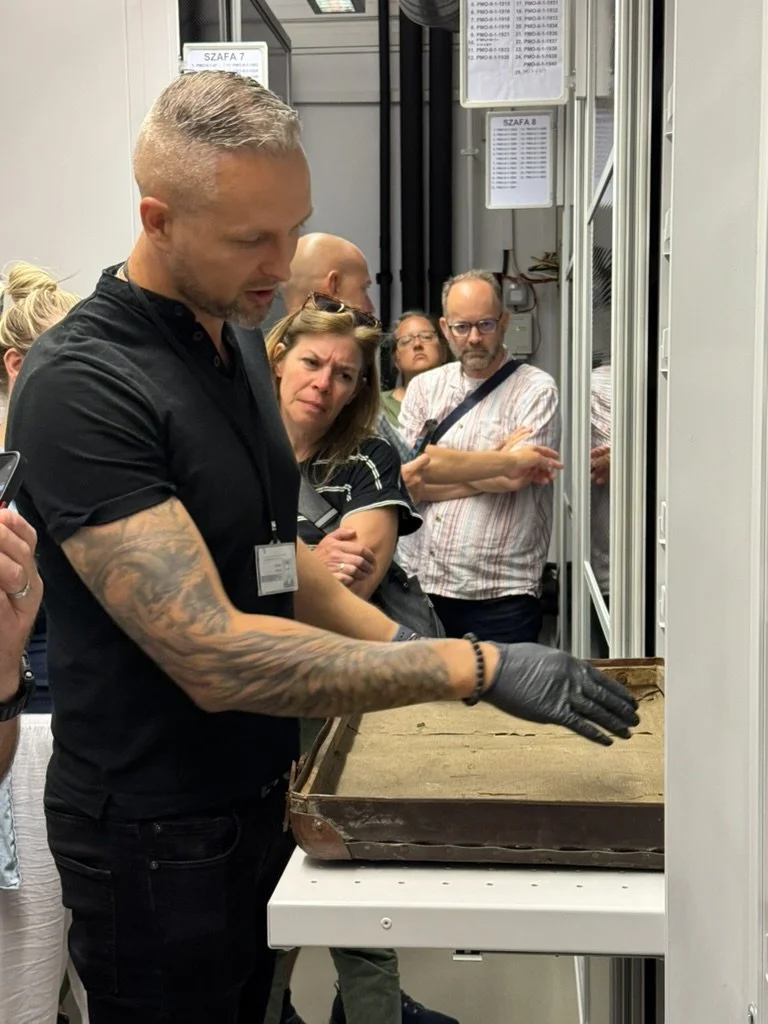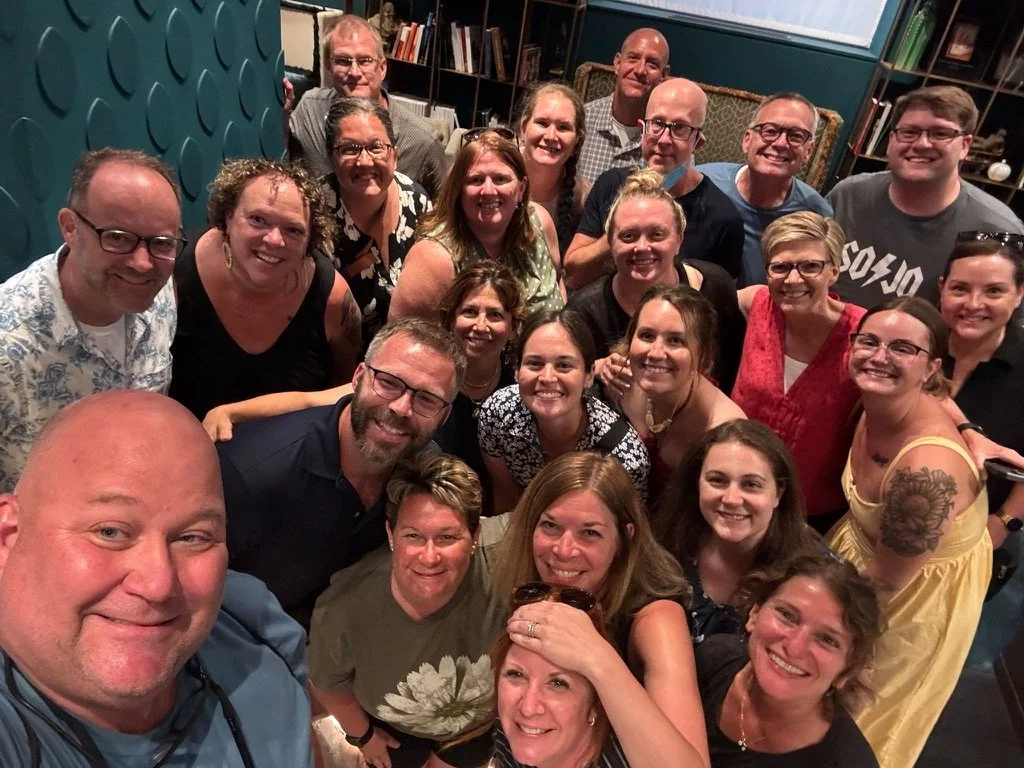Our Work in Action: 2025 “Power of Place”
The 2025 “Power of Place”: European Summer Institute for Holocaust Educators—a transformational journey across Austria, Poland, and Italy—brought 25 educators & facilitators together to explore Holocaust history & pedagogy through immersive, place-based learning.
Beginning in Reflection
We gathered in Linz, Austria, unsure of what lay ahead. In a quiet park, we introduced ourselves—not just by geography or subject area, but by purpose.
Learning Across Borders
Our group—spanning 12 U.S. states and British Columbia—was a wide array of experience: first-year educators, museum professionals, middle & high school teachers, & instructional leaders. In Austria, we were joined by scholars & renowned leaders in the field of Holocaust Education, Paul Salmons & Wolfgang Schmutz.
Our group with Holocaust Education experts and scholars, Paul Salmons and Wolfgang Schmutz. Photo Credit Darrell Owens
I first met Paul in 2016 while working at the U.S. Holocaust Memorial Museum (USHMM) when we co-facilitated a multi-day conference in Ireland. We've stayed in touch, & I was honored to have him with us in Austria, where he spent three days guiding our educators through his participant-centered approach to meaning-making at historical sites.
With Paul & Wolfgang, we moved beyond simple narratives & into difficult inquiry. We would grapple with the questions they posed long after our time in Austria: How were millions murdered in the midst of a civil society? What do we choose to remember—and what do we choose to forget?
At Hartheim Castle—where over 30,000 people with disabilities were killed under Nazi “euthanasia” policy— we humanized victims by studying individual stories & analyzed the role of nearby businesses that benefited from the atrocities.
Next, we visited Mauthausen Concentration Camp Memorial with a sense of foreboding that matched the weather perfectly; overcast skies & intermittent rain. We began at the soccer field where the traveling league of camp guards played while local townspeople watched - yes, that is a strange sentence to even write. Here, where death and brutality were ever present, part of the cruelty was seeing the spectacle of physical fitness & hearing the cheers of spectators while prisoners endured the unspeakable & fought to survive.
At Mauthausen Concentration Camp Memorial. Photo Credit Darrell Owens
In small groups, we designed & facilitated peer-led teaching sessions, drawing from archival sources to explore different camp locations. To engage in site-based pedagogy—on ground marked by suffering—was both humbling & transformative.
Bearing Witness
In Poland, we explored Bielsko-Biała, Bedzin, and Oswiecim. We followed the lives of Gerda Weissmann Klein & Rudka Laskier, whose testimonies anchor countless classroom lessons. In Oswiecim—a town once home to a Jewish majority—we bore witness to absence. Today, just one Jewish resident remains.
We spent a day at Auschwitz-Birkenau, where grief & ritual met pedagogy & presence. For me, this is where the Power of Place speaks most clearly. You cannot grasp its enormity until you stand in silence, turning in every direction—seeing nothing but the camp. The scale overwhelms. The silence teaches.
A member of the Collections Department offered a rare, behind-the-scenes glimpse into personal artifacts—suitcases preserved not for sentiment but for their utility to the perpetrators. These remnants now illuminate the lives of those who carried them, offering fragments of stories nearly lost. We lit yahrzeit candles. We walked the grounds. We held one another. We asked questions not easily answered.
Lukasz Janiga, Collections Dept. at Auschwitz Memorial and Museum, shows our group artifacts that were the personal belongings of Jewish people who passed through the gates of Auschwitz.
Grappling With Complicity and Witnessing Resiliency
In Rome, we explored the Vatican’s role during the Holocaust with my former colleague at USHMM, Dr. Suzanne Brown-Fleming. She leads the Museum’s Vatican Archives Initiative & shared insights into the vast archive—stretching across 85 km of shelving & 12 centuries of history. The collection of documents from 1939–1958 remained sealed until recently. Under Pope Francis, 16 million pages from this critical period—spanning the papacy of Pius XII—were made public. These records provide new opportunities to examine what the Church knew, did, or failed to do during the Holocaust.
Dr. Suzanne Brown-Fleming of USHMM guides our group through the Vatican Archives. Photo Credit: Darrell Owens
We also visited the solemn memorial at the Fosse Ardeatine Caves where 335 lives were erased in silence. Here, we blended Jewish mourning rituals with participant-led reflections of poetry, prayer, & stillness.
Next, we met Federika a& Tobias Wallbrecher—Catholic, of German descent, & founders of Ricordiamo Insieme (“We remember”)—whose family histories span both Nazi affiliation & resistance. Alongside the grandnieces of Settimia Spizzichino, the sole female survivor of the 1943 roundup of Roman Jews, they’ve worked to preserve memory just steps from the Vatican, where over 1,000 Jews were detained before deportation to Auschwitz—an atrocity described as “beneath the Pope’s very windows.” Of those deported, only 16 survived. In 2018, the families secured a plaque in that courtyard, & are working to establish a documentation center by 2026. We were deeply honored to visit the site with them, gaining rare access & witnessing a remarkable interfaith partnership rooted in truth, loss, & remembrance.
What stood out most was visiting Rome’s Jewish Quarter with our guide, Sara Pavoncello. She shared not only an overview of the larger Jewish history during the Holocaust, but also the personal story of her family. As we walked the cobblestone streets, she greeted dozens of people – relatives gathering for a 50th wedding anniversary celebration at the synagogue. What began as solemn remembrance became a living testament to Jewish joy, survival, & resiliency. The energy was palpable & witnessing this Jewish community not only enduring, but thriving, is a moment I will never forget!
Sara Pavoncello greets her Great Uncle (Holocaust survivor) who is celebrating his 50th wedding anniversary today! We were able to watch part of the joyous celebration inside the synagogue. Photo Credit: Darrell Owens
The Ongoing Work
“Power of Place” 2025 created a brave space for memory, pedagogy, & connection. I am deeply honored to plan & lead this program each summer in partnership with the Jewish Community Relations Council of MN & the Dakotas. I look forward to sharing an exciting announcement soon about the 2026 Institute!
What an amazing group of dedicated teachers and fabulous human beings! Thanks for the memories!





